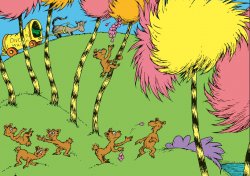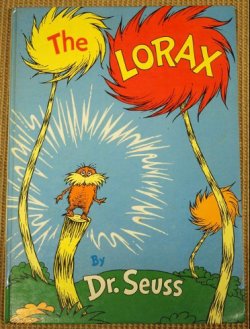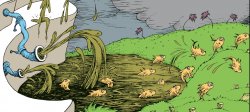
From The Lorax by Dr. Seuss © 1971 by Random House


Reviewed by Megan Jane Laverty
The Lorax (the 1971 book, the 1972 television cartoon, and the 2012 feature film) tells the story of an imaginary place, where the Once-ler now lives, and how it went from being bountiful and joyful to colorless, lifeless, and somber – even the wind smells sour. From his Lerkim on top of his store, the Once-ler recounts – for a fee, via Whisper-ma-Phone – the chain of events that led to the Lorax being “lifted away.” That story begins with the Once-ler’s arrival at this once “glorious place,” filled with Truffula Trees, Brown Bar-ba-loots, Swomee-Swans, and Humming-Fish. Pleased to have discovered the soft tufts of the Truffula Trees, the Once-ler chops one down to knit a multi-purpose Thneed. As soon as the tree falls, however, the Lorax pops out of its stump. He claims to speak for the trees, “for the trees have no tongues,” and indignantly chastises the Once-ler for having felled a precious Truffula for something as trivial as a Thneed. The entrepreneurial Once-ler, however, who immediately sells the Thneed, claims to have done no harm: after all, there are plenty more Truffula Trees. So he invites his family to join him in what becomes a Thneed factory. It is, he says, “a wonderful chance for the whole Once-ler family to get mighty rich.”

From The Lorax by Dr. Seuss © 1971 by Random House
As the demand for Thneeds continues to grow, so too does the need for Truffula tufts. To meet demand, the Once-ler invents the Super-Axe-Hacker, which chops down four Truffula trees at a time. Before too long, he is cutting down vast swaths of Truffulas. This leads the Lorax to speak not only for the trees but also for the Brown Bar-ba-loots, now starved of Truffula Fruits; the Swomee-Swans, now choked by the smog; and the Humming-Fish, now poisoned by the factory waste poured into the lake. In response to the Lorax’s “gripes,” however, the Once-ler’s refrain is: “Business is business! And business must grow.” Dismissing the Lorax’s accusation that he is “crazy with greed,” the Once-ler continues until there are no more Truffula Trees to chop down. With the last Truffula felled, the family moves away, leaving the Once-ler in a place that is gray. At this point, the Lorax has nothing to say. In sadness, he lifts himself up and away. As the only one left, the Once-ler’s message to those who will listen is: “Unless someone like you cares a whole awful lot, nothing is going to get better. It’s not.”
The Lorax works as a philosophical fable on several levels. It is a tragic story of our failure to recognize the value of what we have until it is too late. While it might be difficult to fully sympathize with the Once-ler, we can relate to his commercially enterprising enthusiasm for making Thneeds, his desire to be successful in what he does, and his inclination to share his good fortune with his family. We are familiar with the experience of getting caught up in life in this way: pursuing our projects and failing to care for those around us. Before we know it, we wake up to find ourselves in a very different place from where we started. One question to explore with your students is whether they relate to this tragic predicament: Are they Once-lers? Have they met Once-lers? Do they ever wonder about how to become less Once-ler-like themselves? Along those same lines, you might encourage them to think about how this story could have gone differently: What could they have said to the Once-ler? Who else could have come into the story to interrupt the tragic progress?
To encourage an appreciation for their own worlds, you might invite students to reflect on the rich diversity of their immediate surroundings. You might take your class outside and ask them to pay attention to what is before them: have them take photos, draw, or take notes on what they notice. These photographs, drawings, and notes can serve as the impetus for research about their neighborhood — looking up plant and insect names, for example, or researching the origins of a local park or historic building. In The Lorax, Seuss adopts a favorable attitude towards nature — the illustrations depict it as bright, colorful, and happy — contrasted with the grim picture of contemporary, built-up, industrial environments, which are represented as grey, sad, and dull. However, many students may wish to challenge or at least complicate this contrast: some may not feel comfortable in natural environments and others may wish to defend the life of urban ones (none of which are without natural components). Depending on where students live — rural, suburban, or urban — you might invite them to reflect on the aesthetics of their surroundings: What is beautiful about the world they live in? What is ugly about it?
Another approach is to invite students to interview their parents, grandparents, and great-grandparents about what their local neighborhood was like when they were younger and what they miss most about it now. For example, Henry James regretted that the Manhattan of his youth — a patchwork of farms and estates, with domestic animals — came to be covered in brownstones. The generation after James looked back longingly at the Manhattan that was characterized by brownstones. The next generation after that looked back longingly on the artist colonies and eccentricities that came after genteel life in the brownstones. By interviewing earlier generations, students may come to discern a pattern of regret, as the individuals they speak to acknowledge taking for granted what came to disappear.
The Lorax is also an environmental fable, pitting the interests of the entrepreneurial Once-ler against those of the conservationist Lorax. It can be read as implying that private companies never assume responsibility for their environmental impact. Their view of nature is purely instrumental: an inexhaustible source of material to be exploited, consumed, and profited from. Thus, we need environmental organizations to serve in the role of the Lorax, standing up to these companies in the interest of protecting nature and protecting ourselves from an ecological crisis. In this context, you might invite your students to consider whether all forms of industrialization have such a negative environmental impact or just those forms of it that go unchecked. For example, would the situation have been better if the Once-ler had capped his production and cut down only some of the Truffula Trees? Are there examples of successful deforestation and reforestation?
In The Lorax, the Bar-ba-loots, the Swomee-Swans, and the Humming-Fish are all forced to migrate, which can be read to imply their extinction. Another discussion to have with your students is whether nonhuman nature has rights in the same ways that humans have rights: a right to existence, and a right not to be harmed or interfered with. For example, should any trees be cut down for use by people? Should any non-human animals be domesticated or raised for food? You might invite your students to discuss how these rights should be determined and enforced. They might consider the implications of these rights for their habits of consumption: tourism, food, and fashion.

From The Lorax by Dr. Seuss © 1971 by Random House
Seuss’s story fixes blame on the Once-ler family, but their business would have failed without consumers (not portrayed). It can be important for us to keep in mind that the power such corporations yield is, in part, given to them by consumers. For this reason, students might wish to study their consumption patterns: what brands do they like to purchase, and do they know about the environmental policies of those brands? How many places do they encounter commercial advertising, and how aware are they of the effects of this advertising on their desires? The answers to these empirical questions give rise to philosophical questions as well, such as: Why do we buy so many things that we don’t need? How might we stop having such desires, if we decided we didn’t want to have them?
In his review of The Sneetches — another of Seuss’s moral fables — Gareth B. Matthews observed that Seuss avoids being moralistic by leaving the applications of his fable up to his readers. “We have to think about the ways that we” are complicit in the wrongdoing. Thus, you might invite the students to reflect on whether or not they agree with the morals of The Lorax — and, to the extent they agree, how they can avoid short-sightedness with its tragic consequences and advance environmental justice in their own lives.